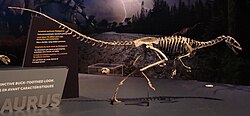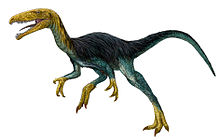
Ceratosaurus was a carnivorous theropod dinosaur that lived in the Late Jurassic period. The genus was first described in 1884 by American paleontologist Othniel Charles Marsh based on a nearly complete skeleton discovered in Garden Park, Colorado, in rocks belonging to the Morrison Formation. The type species is Ceratosaurus nasicornis.

Ceratosaurs are members of the clade Ceratosauria, a group of dinosaurs defined as all theropods sharing a more recent common ancestor with Ceratosaurus than with birds. The oldest known ceratosaur, Saltriovenator, dates to the earliest part of the Jurassic, around 199 million years ago. Ceratosauria includes three major clades: Ceratosauridae, Noasauridae, and Abelisauridae, found primarily in the Southern Hemisphere. Originally, Ceratosauria included the above dinosaurs plus the Late Triassic to Early Jurassic Coelophysoidea and Dilophosauridae, implying a much earlier divergence of ceratosaurs from other theropods. However, most recent studies have shown that coelophysoids and dilophosaurids do not form a natural group with other ceratosaurs, and are excluded from this group.

Masiakasaurus is a genus of small predatory noasaurid theropod dinosaurs from the Late Cretaceous of Madagascar. In Malagasy, masiaka means "vicious"; thus, the genus name means "vicious lizard". The type species, Masiakasaurus knopfleri, was named after the musician Mark Knopfler, whose music inspired the expedition crew. It was named in 2001 by Scott D. Sampson, Matthew Carrano, and Catherine A. Forster. Unlike most theropods, the front teeth of M. knopfleri projected forward instead of straight down. This unique dentition suggests that they had a specialized diet, perhaps including fish and other small prey. Other bones of the skeleton indicate that Masiakasaurus were bipedal, with much shorter forelimbs than hindlimbs. M. knopfleri was a small theropod, reaching 1.8–2.1 m (5.9–6.9 ft) long and weighing 20 kg (44 lb).
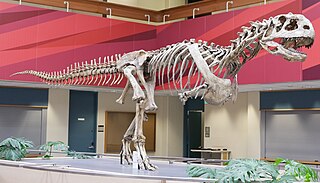
Abelisauridae is a family of ceratosaurian theropod dinosaurs. Abelisaurids thrived during the Cretaceous period, on the ancient southern supercontinent of Gondwana, and today their fossil remains are found on the modern continents of Africa and South America, as well as on the Indian subcontinent and the island of Madagascar. Isolated teeth were found in the Late Jurassic of Portugal, and the Late Cretaceous genera Tarascosaurus and Arcovenator have been described in France. Abelisaurids first appear in the fossil record of the early middle Jurassic period, and at least three genera survived until the end of the Mesozoic era 66 million years ago.

Deltadromeus is a genus of theropod dinosaur from the Aoufous Formation of Morocco.

Abelisauroidea is a diverse superfamily of ceratosaurian dinosaurs, typically regarded as a Cretaceous group, though the earliest abelisaurid remains are known from the Middle Jurassic of Argentina and possibly Madagascar. Possible Abelisauridae remains were also discovered in Late Jurassic Tendaguru Beds in Tanzania.

Elaphrosaurus is a genus of ceratosaurian theropod dinosaur that lived approximately 154 to 150 million years ago during the Late Jurassic Period in what is now Tanzania in Africa. Elaphrosaurus was a medium-sized but lightly built member of the group that could grow up to 6.2 m (20 ft) long. Morphologically, this dinosaur is significant in two ways. Firstly, it has a relatively long body but is very shallow-chested for a theropod of its size. Secondly, it has very short hindlimbs in comparison with its body. Phylogenetic analyses indicate that this genus is likely a ceratosaur. Earlier suggestions that it is a late surviving coelophysoid have been examined but generally dismissed. Elaphrosaurus is currently believed to be a very close relative of Limusaurus, an unusual beaked ceratosaurian which may have been either herbivorous or omnivorous.

Compsosuchus is a dubious genus of abelisauroid dinosaur from the Late Cretaceous Lameta Formation of India.

Majungasaurus is a genus of abelisaurid theropod dinosaur that lived in Madagascar from 70 to 66 million years ago, at the end of the Cretaceous Period, making it one of the last-known non-avian dinosaurs that went extinct during the Cretaceous–Paleogene extinction event. The genus contains a single species, Majungasaurus crenatissimus. This dinosaur is also called Majungatholus, a name which is considered a junior synonym of Majungasaurus.
Genusaurus is a genus of abelisauroid dinosaur from the Early Cretaceous. Its fossils were found in France. Genusaurus is believed to have lived during the Albian stage, around 112-100 million years ago.

Noasaurus is a genus of ceratosaurian theropod dinosaur genus from the late Campanian-Maastrichtian of Argentina. The type and only species is N. leali.
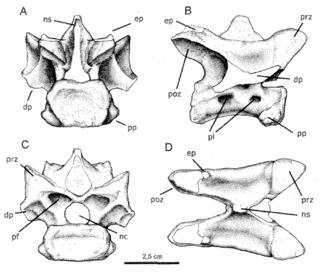
Laevisuchus is a genus of theropod dinosaur from the Late Cretaceous. Its remains were discovered by Charles Alfred Matley near Jabalpur in Maastrichtian "Carnosaur Bed" deposits in the Lameta Formation in Madhya Pradesh, central India, and were named and described by paleontologists Friedrich von Huene and Matley in 1933.
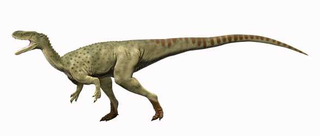
Spinostropheus is a genus of carnivorous neotheropod theropod dinosaur that lived in the Middle Jurassic period and has been found in the Tiouraren Formation, Niger. The type and only species is S. gautieri.

Berberosaurus is a genus of neotheropod dinosaur, possibly a ceratosaur, from the Toarcian-age "Toundoute Continental Series" found in the Central High Atlas of Toundoute, Ouarzazate, Morocco. The type species of the genus Berberosaurus is B. liassicus, in reference to the Lias epoch. Berberosaurus might be the oldest known ceratosaur, and is based on partial postcranial remains. This genus represents the oldest formally identified theropod from the North of Africa, as well one of the few from the region in the Early Jurassic.
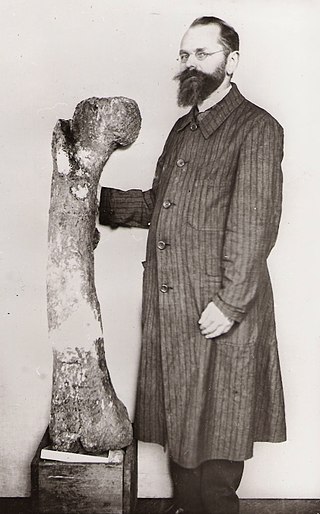
Bahariasauridae is a potential family of averostran theropods that might include a handful of African and South American genera, such as Aoniraptor, Bahariasaurus, Deltadromeus, and Gualicho. The placement of these theropods is controversial, with some studies placing them as basal ceratosaurs possibly related to Noasauridae, others classifying them as megaraptorans, basal neovenatorids, or basal coelurosaurs. There is also a possibility the group might not be monophyletic, as a monograph on the vertebrate diversity in the Kem Kem Beds published in 2020 found Bahariasaurus to be nomen dubium. In the same paper Deltadromeus is classified as an noasaurid, a result also recovered by some previous studies. A 2024 analysis found Aoniraptor, Bahariasaurus, Deltadromeus, Elaphrosaurus and Gualicho to form a monophyletic clade at the base of Ceratosauria.

Limusaurus is a genus of theropod dinosaur that lived in what is now China during the Late Jurassic, around 161 to 157 million years ago. The type and only species Limusaurus inextricabilis was described in 2009 from specimens found in the Upper Shishugou Formation in the Junggar Basin of China. The genus name consists of the Latin words for "mud" and "lizard", and the species name means "impossible to extricate", both referring to these specimens possibly dying after being mired. Limusaurus was a small, slender animal, about 1.7 m in length and 15 kg (33 lb) in weight, which had a long neck and legs but very small forelimbs. It underwent a drastic morphological transformation as it aged: while juveniles were toothed, these teeth were completely lost and replaced by a beak with age. Several of these features were convergently similar to the later ornithomimid theropods as well as the earlier non-dinosaurian shuvosaurids.

Arcovenator is an extinct genus of abelisaurid theropod dinosaurs hailing from the Late Cretaceous of France. The type and only described species is Arcovenator escotae.

This timeline of ceratosaur research is a chronological listing of events in the history of paleontology focused on the ceratosaurs, a group of relatively primitive, often horned, predatory theropod dinosaurs that became the apex predators of the southern hemisphere during the Late Cretaceous. The nature and taxonomic composition of the Ceratosauria has been controversial since the group was first distinguished in the late 19th century. In 1884 Othniel Charles Marsh described the new genus and species Ceratosaurus nasicornis from the Late Jurassic Morrison Formation of the western United States. He felt that it belonged in a new family that he called the Ceratosauridae. He created the new taxon Ceratosauria to include both the Ceratosauridae and the ostrich-like ornithomimids. The idea of the Ceratosauria was soon contested, however. Later that same decade both Lydekker and Marsh's hated rival Edward Drinker Cope argued that the taxon was invalid.

Afromimus is a genus of theropod dinosaur from the Early Cretaceous Elrhaz Formation of Niger. It contains a single species, A. tenerensis, named in 2017 by Paul Sereno from parts of the right leg, vertebrae, and ribs found in the Ténéré Desert. It was originally classified as an ornithomimosaurian, but subsequently it was argued to be an abelisauroid.
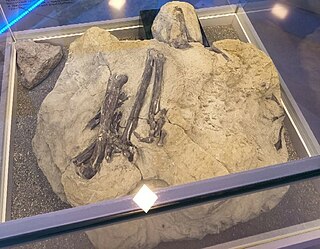
Kiyacursor is an extinct genus of noasaurid theropod dinosaur from the Early Cretaceous Ilek Formation of Russia. The genus contains a single species, K. longipes, known from a partial skeleton. Kiyacursor represents the first Early Cretaceous ceratosaur discovered in Asia, as well as the second non-avian theropod named from Russia, after Kileskus in 2010.
